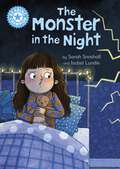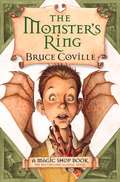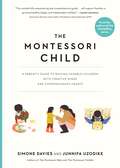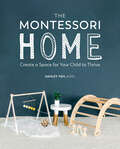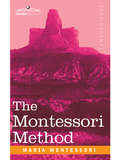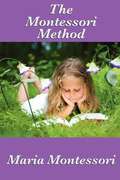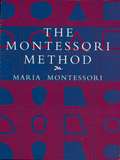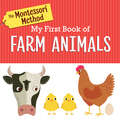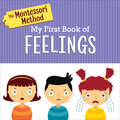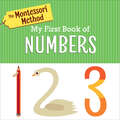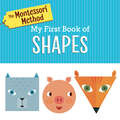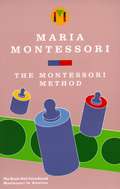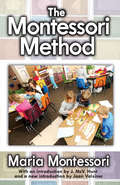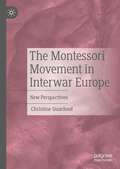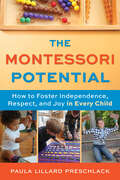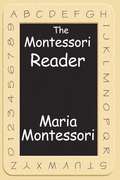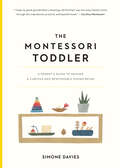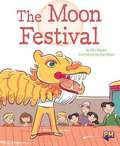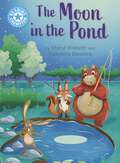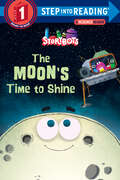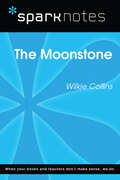- Table View
- List View
The Monster Who Did My Math
by Danny SchnitzleinA math-phobic boy faces another dreaded evening of multiplication when a monster suddenly appears in his room and offers him a deal he cannot refuse.After a quick signature on a contract, the boy's problems are solved, and his homework is ready to turn in the next day. At first, everything adds up perfectly. But when the boy's math knowledge is tested at school, his troubles begin to multiply. What did the fine print on that contract read?"In paragraph seven of clause ninety-three,"If you don't learn anything, do not blame me!"When the bill comes due, will our hero have the money—and the math skills—to subtract that wicked monster from his life once and for all?
The Monster in the Night: Independent Reading Blue 4 (Reading Champion #584)
by Sarah SnashallThis story is part of Reading Champion, a series carefully linked to book bands to encourage independent reading skills, developed with Dr Sue Bodman and Glen Franklin of UCL Institute of Education (IOE)There's a monster in Milly's house, and Milly is sure it's in Mum's bedroom! She goes to investigate ...Reading Champion offers independent reading books for children to practise and reinforce their developing reading skills.Fantastic, original stories are accompanied by engaging artwork and a reading activity. Each book has been carefully graded so that it can be matched to a child's reading ability, encouraging reading for pleasure.Perfect for 5-6 year olds or those reading book band blue 4.
The Monster's Ring
by Bruce CovilleA timid boy, eager to frighten the school bully on Halloween night, acquires a magic ring and the power to change himself into a hideous monster.
The Montessori Child: A Parent's Guide to Raising Capable Children with Creative Minds and Compassionate Hearts (The Parents' Guide to Montessori #3)
by Simone Davies Junnifa UzodikeFrom the bestselling authors of The Montessori Toddler and The Montessori Baby, this book guides parents through the principles of Montessori to enhance their children's development and foster respectful relationships with their families and the world. When children are given independence, the tools to succeed, and the encouragement to build on their abilities, it&’s amazing what they can achieve. The newest book in the bestselling Montessori series is an everything-you-need-to-know guide to raising your school-aged child (from 3–12 years old, with a bonus chapter for the teen years) in the Montessori way. Educators Simone Davies and Junnifa Uzodike provide an in-depth, practical guide to incorporating Montessori principles into readers&’ everyday lives, with advice on everything from setting up your home in ways that encourage curiosity and independence to supporting your child&’s social and moral development with a balance of limit-setting and age-appropriate freedoms. The book includes dozens of hands-on activities to help foster your child's love of numbers and literacy, art and science, and ones that encourage community-building, social awareness, and connection with the natural world. The Montessori Child offers a powerful alternative for parents who feel that family life has gotten too complicated by showing parents how to make more intentional choices for your family, how to better understand the needs of your children, and support them as they develop their unique potential.
The Montessori Home: Create a Space for Your Child to Thrive
by Ashley YehCalm the chaos and transform your home into a space that fosters curiosity, creativity, and independenceToo often, the toys, games, and other materials meant to educate young children end up being a detriment instead. If you're overwhelmed and your kids are overstimulated, it's time to reset your space by applying the principles of the Montessori method at home so you can be a calmer, more attentive parent. Author and certified Montessori guide Ashley Yeh tackles each room of the home and explains how to provide young children with the accessibility they need to complete practical life skills on their own, tapping into their innate desire to "do it myself." Whether your child is an infant, toddler, or preschooler, there are simple and inexpensive changes you can make to foster indpendence and reduce the stress around mealtimes, bedtime, and leaving the house. Includes: • Introduction to the Montessori method, which emphasizes whole-child development and learning through experience • How to apply Montessori principles throughout the home so that children are able to complete practical, everyday tasks on their own • Over 75 simple activities for ages 0–5 • Essential Montessori resources and materials with DIY options
The Montessori Method
by Maria MontessoriThis groundbreaking classic of educational philosophy takes on urgent new necessity today, as "traditional" methods of early-childhood schooling seem to be failing us. Published in Italian in 1909 and first translated into English in 1912, these still-revolutionary theories focus on the individuality of the child and on nurturing her inherent joy of learning to create schools and other learning environments that are oriented on the child. Eschewing rote memorization and drilling, Montessori's method helps to foster abstract thinking and to fulfill a child's highest potential, emotionally, physically and intellectually. Parents from all walks of life will find the ideas herein immensely valuable.
The Montessori Method
by Maria MontessoriThe Montessori method is characterized by an emphasis on self-directed activity on the part of the child and clinical observation on the part of the teacher. It stresses the importance of adapting the child's learning environment to his or her developmental level, and of the role of physical activity in absorbing abstract concepts and practical skills. The Montessori method teaches reading via phonics and whole language, the comparative benefits of which are currently being recognized. To all educators this book should prove most interesting. All who are fair-minded will admit the genius that shines from the pages which follow, and the remarkable suggestiveness of Dr. Montessori's labors. -Henry W. Holmes
The Montessori Method
by Maria MontessoriThis is, quite simply, one of the landmark books in the history of education. Written by influential Italian educator Maria Montessori (1870–1952), it describes a new system for educating young children based on materials and methods she originally developed to teach retarded students. The techniques proved highly effective with normal children as well. Her system, based on a radical conception of liberty for the pupil and a highly formal training of separate sensory, motor, and mental capacities, led to rapid and substantial mastery of reading, writing, and arithmetic. In The Montessori Method (1912), her first book, Dr. Montessori outlines her techniques in discussions of such topics as scientific pedagogy; discipline; diet; gymnastics; manual labor; education of the senses; methods for teaching reading, writing, and arithmetic; and many other topics. The Dover edition is the least expensive edition available, making this seminal classic widely accessible to teachers, principals, parents — anyone interested in the education of young children.
The Montessori Method: My First Book of Farm Animals
by RodaleLearn about concepts the Montessori way with this line of board books following the world-leading educational approach, THE MONTESSORI METHOD!Montessori education values the development of the whole child--physically, socially, emotionally, and cognitively. These books tap into the Montessori Method at home, allowing children to discover and engage with concepts in a holistic way that promotes a drive for knowledge and self-motivation. In FARM ANIMALS, children are invited to play hide-and-seek with baby animals on the farm, using features like ears or feathers to identify the hiding animals. Infused with humor and concepts that both engage and challenge children, this book is sure to inspire a generation of animal lovers!Learn more with THE MONTESSORI METHOD: MY FIRST BOOK OF FEELINGS, MY FIRST BOOK OF NUMBERS, and MY FIRST BOOK OF SHAPES.
The Montessori Method: My First Book of Feelings
by The Montessori MethodLearn about feelings the Montessori way with this line of board books following the world-leading educational approach, THE MONTESSORI METHOD!Montessori education values the development of the whole child-physically, social, emotionally, cognitively. These books tap into the Montessori Method at home, allowing children to discover and engage with concepts in a holistic way that promotes a drive for knowledge and self-motivation. In FEELINGS, children are invited to identify, imagine, mimic, and learn about feelings and how they affect in the world around us! Through color association and silly, relatable examples, children will learn emotional literacy at a young age.Learn more with the Montessori Method: NUMBERS!
The Montessori Method: My First Book of Numbers
by The Montessori MethodLearn about numbers the Montessori way with this line of board books following the world-leading educational approach, THE MONTESSORI METHOD!Montessori education values the development of the whole child-physically, socially, emotionally, cognitively. These books tap into the Montessori Method at home, allowing children to discover and engage with concepts in a holistic way that promotes a drive for knowledge and self-motivation. In NUMBERS, children are invited to imagine, touch, mimic, and learn about numbers and how they function in the world around us. Infused with humor and math concepts that both engage and challenge children, this book is sure to inspire a generation of mathematicians!Learn more with THE MONTESSORI METHOD: FEELINGS!
The Montessori Method: My First Book of Shapes
by RodaleLearn about shapes the Montessori way with this line of board books following the world-leading educational approach, THE MONTESSORI METHOD!Montessori education values the development of the whole child--physically, socially, emotionally, and cognitively. These books tap into the Montessori Method at home, allowing children to discover and engage with concepts in a holistic way that promotes a drive for knowledge and self-motivation. In SHAPES, children are invited to learn the names of shapes and how to identify them in the world. Infused with humor and concepts that both engage and challenge children, this book is sure to ignite an interest in geometry!Learn more with THE MONTESSORI METHOD: MY FIRST BOOK OF FEELINGS, MY FIRST BOOK OF NUMBERS, and MY FIRST BOOK OF FARM ANIMALS.
The Montessori Method: Scientific Pedagogy As Applied To Child Education In The Children's Houses
by Maria MontessoriThis book is Montessori's own exposition of the theory behind her innovative educational techniques. She shows parents, teachers and administrators how to "free a child to learn through his own efforts".
The Montessori Method: Scientific Pedagogy As Applied To Child Education In The Children's Houses With Additions And Revisions By The Author - Scholar's Choice Edition
by Maria Montessori Jaan Valsiner J. McV. HuntMaria Montessori's method of educating children, which she details in this book, is based on a conception of liberty for the pupil; it entails formal training of separate sensory, motor, and mental capacities; and leads to rapid and substantial mastery of the elements of reading, writing, and arithmetic. The Montessori Method is important because it springs from a combination of sympathy and intuition, social outlook, scientific training, intensive study of educational problems and the author's unusual experience as a teacher and educational leader. Following opening statements from J. McV. Hunt and Jaan Valsiner, Maria Montessori discusses topics including pedagogical methods used in the children's houses, discipline, diet, gymnastics, manual labor, education of the senses, intellectual education, methods of teaching reading and writing, language in childhood, and teaching of numeration. This classic volume in the education of children takes on urgent relevance for parents, teachers, and administrators in all parts of our society. The suburban mother seeking an environment of "structured freedom" for an imaginative, quick-learning pre-schooler; the educator jolted into awareness that slum children are irreparably handicapped by cultural impoverishment before the age of six; explorers of "new" techniques of teaching reading, of programmed instruction and learning by conditioning and reinforcement-by-approval-all these are instructed by Maria Montessori's theory and the reports of her work in the Casa dei Bambini in the slum quarter of Rome.
The Montessori Movement in Interwar Europe: New Perspectives
by Christine QuarfoodThis book explores how the Montessori movement developed a cultural critique and gained momentum during the interwar years of political turbulence. Drawing on archival sources, press material and Montessori's literary output, the book provides a multifaceted analysis of this significant educational movement. The first two chapters presents the scientific background, how Montessori's innovative method offered new solutions to age-old problems of teacher-pupil interaction. The following chapters focus on the social and psycho-pedagogical aspects of Montessorism, and how the movement's culture-critical message about the child's liberation was received and reinterpreted in the wider European public debate. The last four chapters shed new light on the politicisation of Italian Montessorism during the problematic Montessori-Mussolini alliance, 1924-1934.
The Montessori Potential: How to Foster Independence, Respect, and Joy in Every Child
by Paula Lillard PreschlackChildren's future successes depend on developing the abilities to innovate, be resilient in the face of their mistakes, problem-solve creatively, and collaborate with peers effectively. However, standard American educational practices—stressing memorization, grades, and testing—are failing to foster these skills. There is one complete system of education that effectively supports the natural development of such essential abilities: Montessori. Montessori education expert Paula Lillard Preschlack offers a clear explanation of how the Montessori approach helps children. By looking closely at authentic Montessori practices, she shows the tight correlation between the Montessori system in action and children practicing and strengthening the very traits they will need for adulthood. When implemented properly, Montessori can ensure positive outcomes for generations of children—The Montessori Potential shows exactly how this is done in private and public schools, and at home.
The Montessori Reader
by Maria MontessoriThe Montessori method revolutionized how children were educated. The Montessori method is characterized by an emphasis on self-directed activity on the part of the child, using specialized materials that are presented very precisely by the teacher. It stresses the importance of adapting the child's learning environment to his or her developmental level, and of the role of physical activity in absorbing abstract concepts and practical skills. Collected here in this 3-in-1 omnibus edition are Maria Montessori's three most important works: The Absorbent Mind, Dr. Montessori's Own Handbook, and The Montessori Method. The Absorbent Mind was Maria Montessori's most in-depth work on her educational theory, based on decades of scientific observation of children. Her view on children and their absorbent minds was a landmark departure from the educational model at the time. This book helped start a revolution in education. Since this book first appeared there have been both cognitive and neurological studies that have confirmed what Maria Montessori knew decades ago. In Dr. Montessori's Own Handbook, Maria Montessori explains the basic of her system, how it works and why it works. There are dozens of figures to help illustrate her points. "My method is scientific, both in its substance and in its aim. It makes for the attainment of a more advanced stage of progress, in directions no longer only material and physiological." The Montessori Method teaches reading via phonics and whole language, the comparative benefits of which are currently being recognized. To all educators this book should prove most interesting. All who are fair-minded will admit the genius that shines from the pages which follow, and the remarkable suggestiveness of Dr. Montessori's labors. -Henry W. Holmes
The Montessori Toddler: A Parent's Guide to Raising a Curious and Responsible Human Being
by Simone DaviesTurn a regular home into a Montessori home—and become a more mindful, attentive, and easy going parent. It’s time to change the way we see toddlers. <P><P>Using the principles developed by the educator Dr. Maria Montessori, Simone Davies shows how to turn life with a “terrible two” into a mutually rich and rewarding time of curiosity, learning, respect, and discovery. With hundreds of practical ideas for every aspect of living with a toddler, here is how to: <br>Stay composed when your toddler is not and set limits with love and respect <br>Set up your home and get rid of the chaos <br>Create Montessori activities that are just right for your one-to-three-year-old <br>Raise an inquisitive learner who loves exploring the world around them <br>See the world through your toddler’s eyes and be surprised and delighted by their perspective <P><P>With its bright, airy design and colorful illustrations and photographs, the book captures the feelings and conveys the values of a real Montessori classroom—now in your home.
The Moody Handbook of Messianic Prophecy: Studies and Expositions of the Messiah in the Old Testament
by Michael Rydelnik and Edwin BlumThe ultimate, all-in-one resource on what the Old Testament says about JesusAs Jesus walked the Emmaeus road, he showed his companions how the whole of Scripture foretold his coming. Yet so often today we&’re not quite sure how to talk about Jesus in the Old Testament. How do you know what applies to Jesus? And how do you interpret some of the strange prophetic language?Get answers and clarity in this authoritative and reliable guide to messianic prophecy from some of the world&’s foremost evangelical Old Testament scholars. In this in-depth, user-friendly one volume resource you get: -essays from scholars on the big ideas and major themes surrounding Messianic prophecy-A clear and careful commentary on every passage in the Old Testament considered Messianic -Insights into the original Hebrew and helpful analysis of theological implicationsWatch the Scriptures come into full color as you see new meaning in familiar passages and further appreciate God&’s masterful handiwork in preparing the way for Jesus, the long-awaited Messiah.
The Moody Handbook of Messianic Prophecy: Studies and Expositions of the Messiah in the Old Testament
by Michael Rydelnik and Edwin BlumThe ultimate, all-in-one resource on what the Old Testament says about JesusAs Jesus walked the Emmaeus road, he showed his companions how the whole of Scripture foretold his coming. Yet so often today we&’re not quite sure how to talk about Jesus in the Old Testament. How do you know what applies to Jesus? And how do you interpret some of the strange prophetic language?Get answers and clarity in this authoritative and reliable guide to messianic prophecy from some of the world&’s foremost evangelical Old Testament scholars. In this in-depth, user-friendly one volume resource you get: -essays from scholars on the big ideas and major themes surrounding Messianic prophecy-A clear and careful commentary on every passage in the Old Testament considered Messianic -Insights into the original Hebrew and helpful analysis of theological implicationsWatch the Scriptures come into full color as you see new meaning in familiar passages and further appreciate God&’s masterful handiwork in preparing the way for Jesus, the long-awaited Messiah.
The Moon (Smithsonian)
by James BuckleyCheck out the moon—in all its phases—in this new Level 4 Penguin-Smithsonian nonfiction reader.There are myths about it. Men have landed on it. Just about everybody has gazed at it in wonder. But what is the moon? Where did it come from? What&’s it made of? Find out in this lively reader about the celestial body that&’s so familiar and yet so mysterious.
The Moon Festival (Into Reading, Level N #66)
by Paul Könye Julie HaydonNIMAC-sourced textbook <p><p> Uncle Han took me and my cousin Oliver to the Moon Festival yesterday. We ate moon cakes, decorated lanterns and even saw some fireworks. It was a very exciting day.
The Moon in the Pond: independent Reading Blue 4 (Reading Champion #519)
by Sheryl WebsterThis story is part of Reading Champion, a series carefully linked to book bands to encourage independent reading skills, developed with Dr Sue Bodman and Glen Franklin of UCL Institute of Education (IOE)In this retelling of a traditional tale, Brer Rabbit plays a trick on Bear and Fox, and makes them believe the Moon has fallen into a pond and needs fishing out! Reading Champion offers independent reading books for children to practise and reinforce their developing reading skills.Fantastic stories are accompanied by engaging artwork and a reading activity. Each book has been carefully graded so that it can be matched to a child's reading ability, encouraging reading for pleasure. This retelling of the original traditional tale is suitable for children aged 5-7, or those reading at book band Blue.
The Moon's Time to Shine (Step into Reading)
by StorybotsJust in time for the 50th anniversary of the moon landing! The inquisitive crew from the award-winning StoryBots apps, videos, and Emmy Award-winning Netflix show star in a Step 1 reader that is over the moon!Children will recognize the signature catchy rhymes and colorful art from the StoryBots' popular YouTube video "The Moon's Time to Shine." They will learn that the moon orbits Earth, that--in spite of glowing brightly--it doesn't make its own light, and more! Step 1 readers feature big type and easy words for children who know the alphabet and are eager to begin reading. Rhyming text is paired with picture clues to help children decode the story.
The Moonstone (SparkNotes Literature Guide Series)
by SparkNotesThe Moonstone (SparkNotes Literature Guide) by Wilkie Collins Making the reading experience fun! Created by Harvard students for students everywhere, SparkNotes is a new breed of study guide: smarter, better, faster. Geared to what today's students need to know, SparkNotes provides: *Chapter-by-chapter analysis *Explanations of key themes, motifs, and symbols *A review quiz and essay topicsLively and accessible, these guides are perfect for late-night studying and writing papers

